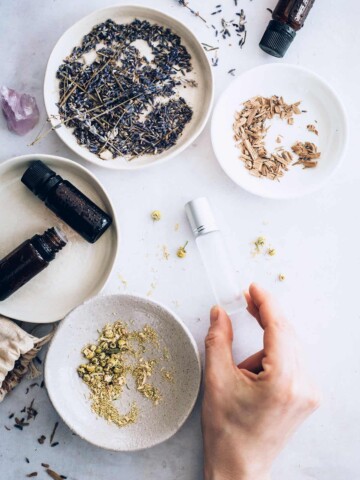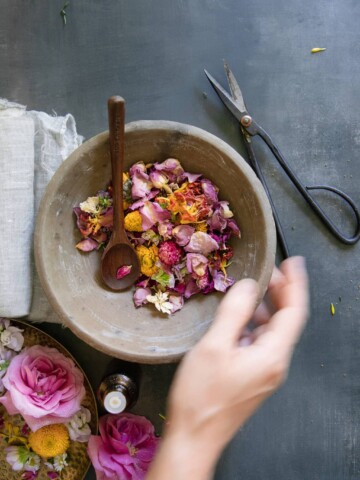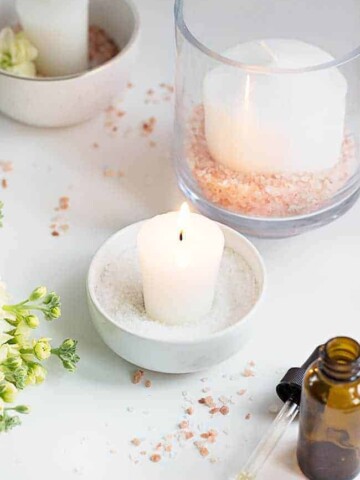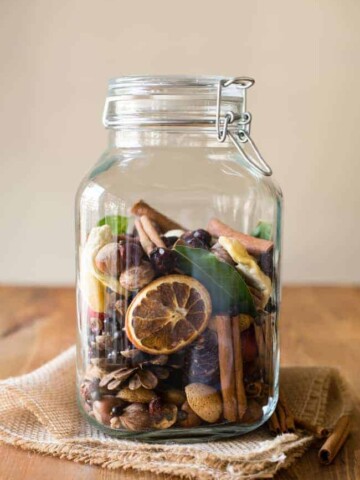The holidays are a notoriously stressful time of year. Celebrating the season seems impossible sometimes, especially with the kids out of school and credit card bills looming! Whether you're running your essential oil diffuser in your home or wearing essential oil jewelry, the EOs you choose to diffuse can certainly affect your stress levels and help you bring on the calm. We're sharing 12 of our favorite essential oil blends for stress relief.
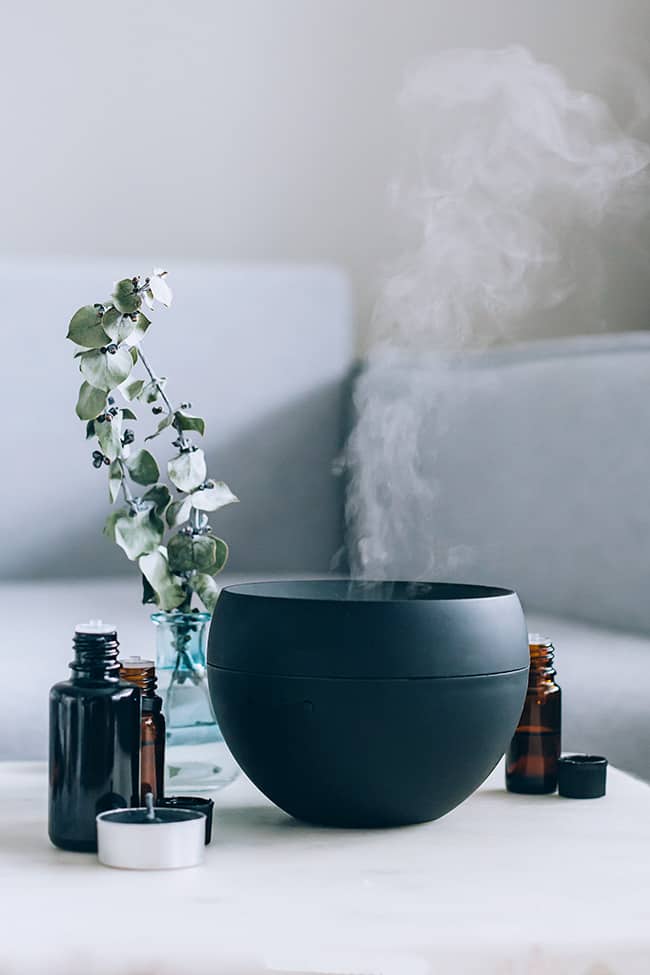
Can aromatherapy help reduce stress?
The use of essential oils to aid in stress relief is becoming more popular today as a natural alternative to medications. Stress is caused by some sort of negatively perceived situation, and although essential oils cannot magically make a situation disappear, there are known benefits from the relaxation effects that aromatherapy offers.
Anxiety (and, on the other side, joy!) originates from the limbic system, the part of the brain that controls emotions [source]. Out of all our senses, the sense of smell is the only one linked to this part of the brain.
And maybe even before we become aware of the effects a particular oil or fragrance may have on us, molecules from the essential oils we smell are already at work on our limbic lobe.
We breathe in the soothing scents, and the oil's teeny tiny chemical compounds reach our olfactory nerves, which then send messages to the brain to release serotonin or endorphins. Those hormones impact our mood and emotions. That's how inhaling essential oils for stress can result in emotional stability, calmness, and relaxation.
Much of aromatherapy research has centered on lavender [source] and has concluded that inhaling lavender reduces stress in intensive care unit patients, postpartum women, high school students, and even dental patients! Other studies have found that lavender is an excellent natural remedy to treat insomnia and improve sleep quality [source].
But you don't have to limit yourself to just lavender. Many essential oils have the same stress-relieving chemical compounds found in lavender. Here's how those chemical compounds work.
What oils should I diffuse?
Some of the most popular essential oils used to combat stress are lavender, geranium, jasmine (a favorite of mine!), rose, frankincense, and citrus oils. We've put together some of the best stress-away recipes below for you to try in your home diffuser or essential oil jewelry.
Blend #1: Lavender, Frankincense, Orange
Lavender has a very calming and relaxing scent, which may be helpful in alleviating both physical and emotional stress. Studies have shown that smelling lavender may help reduce feelings of anxiety, stress, and even depression [source].
Lavender also has been shown to decrease blood pressure, heart rate, and skin temperature, which indicates a decrease in the body’s stress response and a relaxing effect overall [source].
Frankincense EO is believed by many to help lift stress and improve attitude. This well-known tree resin has a long history of use, both medicinally [source] and in religious ceremonial settings.
Orange EO is very uplifting, like many of the citrus oils. One university study found that orange and other citrus scents helped promote relaxation [source]—something much needed this time of year!
Diffuse this combination of essential oils:
—4 drops lavender
—4 drops orange
—2 drops frankincense
Adjust the number of drops to accommodate your diffuser's instructions.
Blend #2: Lavender, Roman Chamomile, Ylang Ylang
Roman chamomile has a calming scent that may help ease anxiety and stress. For many years, chamomile has been used to help promote a calm environment [source].
The influence of ylang ylang (“flower of flowers”) may be beneficial when dealing with mood issues due to its harmonizing and relaxing properties [source]. This EO has been shown to help regulate blood pressure and heart rate, making the subjects feel calmer [source].
Diffuse this combination of essential oils:
—5 drops lavender
—3 drops Roman chamomile
—1–2 drops ylang ylang
Adjust the number of drops to accommodate your diffuser's instructions.
Blend #3: Bergamot, Patchouli, Ylang Ylang
Bergamot is another personal favorite of mine! I love its calming scent, which helps lift my mood almost immediately. Historically, it has been used for its medicinal benefits [source].
Patchouli's distinct aroma is believed to have a relaxing effect (love using this one near the end of the day), which is why it's a favorite for so many!
Diffuse this combination of essential oils:
—5 drops bergamot
—3 drops patchouli
—2 drops ylang ylang
Adjust the number of drops to accommodate your diffuser's instructions.
Blend #4: Lavender, Lime, Mandarin
Lime has been used for its potent antibacterial properties [source].
The scent of mandarins promotes happiness, and it smells wonderful combined with lavender and lime.
Diffuse this combination of essential oils:
—4 drops lime
—4 drops mandarin
—2 drops lavender
Adjust the number of drops to accommodate your diffuser's instructions.
Blend #5: Bergamot, Geranium, Lavender
Geranium is a great essential oil for anxiety, as this study showed with women in labor [source]. It's wonderful when blended with bergamot and lavender, and the three together may help ease feelings of nervous tension, lift the spirits, and bring an overall sense of balance and emotional calm.
Diffuse this combination of essential oils:
—4 drops geranium
—4 drops bergamot
—2 drops lavender
Adjust the number of drops to accommodate your diffuser's instructions.
Blend #6: Sandalwood, Clary Sage, Bergamot
The rich, woodsy scent of sandalwood is so pleasant you'll want to slow down and take a few deep breaths. That musky aroma has been used for centuries in Ayurvedic medicine, yoga, and meditation to promote feelings of connection and grounding [source].
Clary sage has an incredible aroma, and studies are finding that it has an antidepressant-like effect as well [source].
Diffuse this combination of essential oils:
—5 drops sandalwood
—3 drops clary sage
—2 drops bergamot
Adjust the number of drops to accommodate your diffuser's instructions.
Blend #7: Rosemary, Peppermint, Lavender
This is one of my absolute favorite essential oil blends for stress.
Rosemary's fresh herbaceous aroma is invigorating to the mind, and it's great if you've been feeling a bit down. In fact, in combination with lavender, it has been shown to improve symptoms of anxiety and depression [source]. It also contains analgesic properties that can help with physical pain [source].
Peppermint essential oil contains menthol, which is frequently used in pain-relieving formulations, especially for musculoskeletal pain [source].
When these three essential oils are used together, you've got an energy essential oil blend sure to make you feel invigorated and ready to take on the day!
Diffuse this combination of essential oils:
—5 drops lavender
—3 drops rosemary
—2 drops peppermint
Adjust the number of drops to accommodate your diffuser's instructions.
Blend #8: Marjoram, Roman Chamomile, Frankincense
The spicy, herbal aroma of marjoram is traditionally believed to have emotional aromatherapy benefits similar to lavender. Sometimes referred to as the "herb of happiness," marjoram contains a number of therapeutic properties [source].
It pairs well with Roman chamomile for a sleep-inducing bath blend.
Diffuse this combination of essential oils:
—4 drops marjoram
—4 drops Roman chamomile
—2 drops frankincense
Adjust the number of drops to accommodate your diffuser's instructions.
Blend #9: Geranium, Mandarin, Bergamot
One of my biggest sources of anxiety is anticipatory stress—all of the thinking and worrying about something before it happens. That's where this blend shines! Geranium, mandarin, and bergamot make a lovely blend that helps me feel secure when I'm having anxious thoughts.
Diffuse this combination of essential oils:
—4 drops geranium
—4 drops mandarin
—2 drops bergamot
Adjust the number of drops to accommodate your diffuser's instructions.
Blend #10: Grapefruit, Juniper Berry, Rosemary
Grapefruit is another uplifting citrus oil that works well when you need an energy boost. The zesty aroma is sure to help you feel brighter and help you let go of negative feelings.
Juniper berry has a light, clean aroma that pairs excellently with grapefruit. Although scientific studies are lacking, this lovely oil has traditionally been used to promote feelings of calm and relaxation.
Diffuse this combination of essential oils:
—5 drops grapefruit
—3 drops juniper berry
—2 drops rosemary
Adjust the number of drops to accommodate your diffuser's instructions.
Blend #11: Frankincense, Lavender, Cedarwood
Cedarwood is another woodsy oil that has an affinity for the nervous system. Cedrol is one of its main components and has been shown to exhibit sedative effects in mice [source]. This EO is perfect for those times when you're wound up with nervous energy and are having a hard time getting to sleep!
Diffuse this combination of essential oils:
—4 drops frankincense
—4 drops lavender
—2 drops cedarwood
Adjust the number of drops to accommodate your diffuser's instructions.
Blend #12: Clary Sage, Lemon, Ginger
Lemon is yet another citrus essential oil that helps combat feelings of anxiety. Its fruity aroma is great for helping you feel less stressed and boosting your mood in general [source].
Ginger EO is known for its helpful effects on nausea or vomiting [source]. So if an upset stomach tends to accompany your anxiety, this EO blend is a great option to consider!
Diffuse this combination of essential oils:
—5 drops clary sage
—3 drops lemon
—2 drops ginger
Adjust the number of drops to accommodate your diffuser's instructions.
How to Use Essential Oil Blends for Stress Relief
There are a few different ways to reap the relaxing benefits of aromatherapy. If you plan to diffuse oils into the air, just make sure that they're pet- and child-friendly first. If they're not, use a handheld personal diffuser instead.
More ways to use essential oils for stress:
—Mix 2–3 drops in a tablespoon of carrier oil and apply to your pulse points whenever you're feeling stressed
—Use a diffuser bracelet
—Make aromatherapy essential oil candles
—Spritz it in the air
—Whip up a super simple reed diffuser
—Make your own soy wax melts
—Put a few drops in a car diffuser
Essential Oils for Stress FAQ
Where do I apply essential oils?
If applying essential oils directly to skin, mix 2–3 drops with a tablespoon of carrier oil and apply to your wrists, crooks of the elbow, neck just below the jar, behind the ears, and any other pulse points.
What essential oil is good for tension headaches?
Peppermint oil is great for relieving tension headaches caused by stress and anxiety. Thanks to its cooling menthol component, peppermint oil helps stimulate blood flow and calm tense muscles.
How many drops of oil should I use in my diffuser?
Make sure to read your diffuser's instructions to find out how many drops of oil are recommended for your particular machine. If it doesn't say, start with 6–9 drops per 200 mL of water.
Why doesn't my essential oil diffuser smell?
If the essential oil blend you're using is too diluted, you may not pick up much of a scent. Make sure you're only putting pure, 100% undiluted essential oils (or a blend of essential oils) in your diffuser. If you still don't notice the aroma, try adding an extra 2–3 drops of oil and see what happens.
References (in order of appearance):
1. Roxo MR, et al. The limbic system conception and its historical evolution. ScientificWorldJournal. 2011.
2. Koulivand PH, et al. Lavender and the nervous system. Evid Based Complement Alternat Med. 2013.
3. Lillehei AS, et al. Effect of inhaled lavender and sleep hygiene on self-reported sleep issues: a randomized controlled trial. J Altern Complement Med. 2015.
4. Sayorwan W, et al. The effects of lavender oil inhalation on emotional states, autonomic nervous system, and brain electrical activity. J Med Assoc Thai. 2012.
5. Al-Yasiry ARM., et al. Frankincense - therapeutic properties. Postepy Hig Med Dosw (Online). 2016.
6. Igarashi M, et al. Effects of olfactory stimulation with rose and orange oil on prefrontal cortex activity. Complement Ther Med. 2014.
7. Srivastava JK, et al. Chamomile: a herbal medicine of the past with bright future. Mol Med Report. 2010.
8. Tan LTH, et al. Traditional uses, phytochemistry, and bioactivities of Cananga odorata (ylang-ylang). Evid Based Complement Alternat Med. 2015.
9. Jung DJ, et al. Effects of ylang-ylang aroma on blood pressure and heart rate in healthy men. J Exerc Rehabil. 2013.
10. Navarra M, et al. Citrus bergamia essential oil: from basic research to clinical application. Front Pharmacol. 2015.
11. Dosoky NS, et al. Biological activities and safety of Citrus spp. essential oils. Int J Mol Sci. 2018.
12. Fakari FR, et al. Effect of inhalation of aroma of geranium essence on anxiety and physiological parameters during first stage of labor in nulliparous women: a randomized clinical trial. J Caring Sci. 2015.
13. Rajsmita B, et al. Re-discovering sandalwood: beyond beauty and fragrance. Indian Dermatol Online J. 2019.
14. Seol GH, et al. Antidepressant-like effect of Salvia sclarea is explained by modulation of dopamine activities in rats. J Ethnopharmacol. 2010.
15. Alaoui CE, et al. Modulation of T-type Ca2+ channels by lavender and rosemary extracts. PLoS One. 2017.
16. Raskovic A, et al. Analgesic effects of rosemary essential oil and its interactions with codeine and paracetamol in mice. Eur Rev Med Pharmacol Sci. 2015.
17. Topp R, et al. The effect of either topical menthol or a placebo on functioning and knee pain among patients with knee OA. J Geriatr Phys Ther. 2013.
18. Bina F, et al. Sweet marjoram: a review of ethnopharmacology, phytochemistry, and biological activities. J Evid Based Complementary Altern Med. 2017.
19. Kagawa D, et al. The sedative effects and mechanism of action of cedrol inhalation with behavioral pharmacological evaluation. Planta Med. 2003.
20. Komiya M, et al. Lemon oil vapor causes an anti-stress effect via modulating the 5-HT and DA activities in mice. Behav Brain Res. 2006.
21. Lee YR, et al. Effectiveness of ginger essential oil on postoperative nausea and vomiting in abdominal surgery patients. J Altern Complement Med. 2017.
This post was medically reviewed by Dr. Holly Smith, a board-certified physician in nephrology and internal medicine with a background in nutrition. Learn more about Hello Glow's medical reviewers here. As always, this is not personal medical advice, and we recommend that you talk with your doctor.
671

